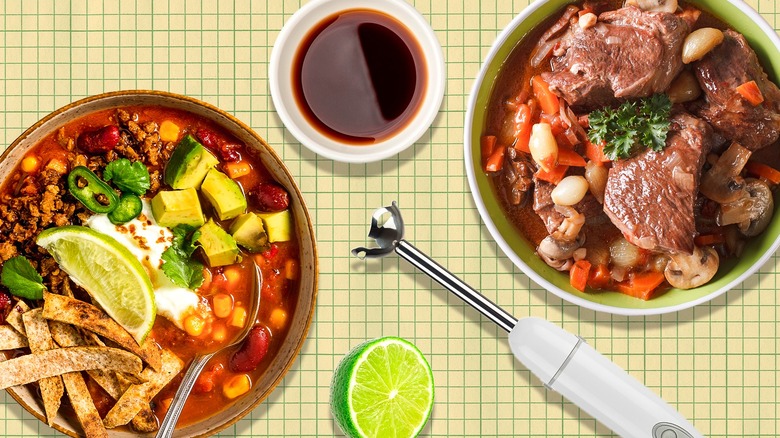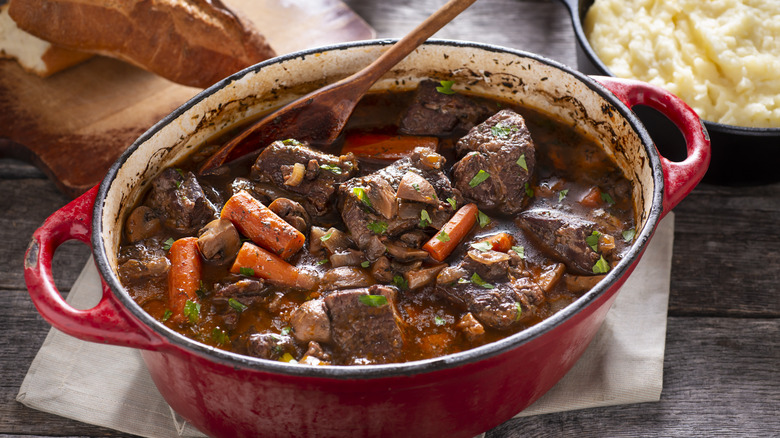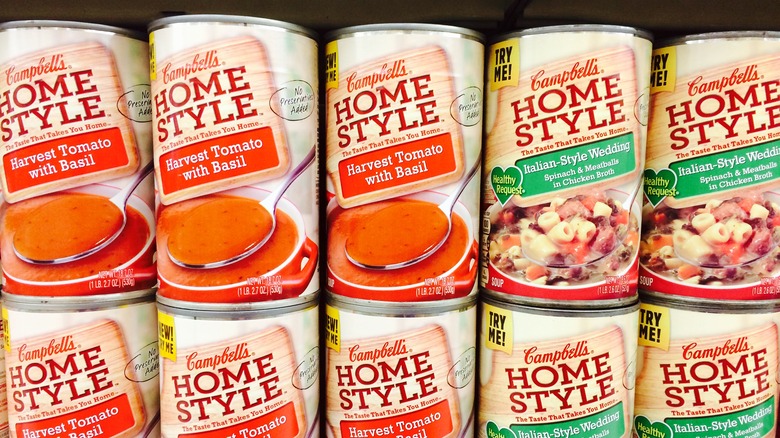12 Hacks That Will Totally Change The Way You Make Soups And Stews
There's nothing as satisfying as a bowl of bubbling hot soup or stew on a cold evening. It's a family-friendly option that can feed a few mouths or be made for one with enough leftovers for a couple of days. There are so many tasty recipes to make, and most are pretty accessible to any home cook. Both soup and stew follow the same concept of boiling or simmering ingredients with water or stock. They can be an easy one-pot meal, but there are a couple of complicated steps that you need to do for specific dishes.
If you're making beef stew, often you're browning the meat first, removing it from the pot, and then adding it at the end. Or you could be adding in a roux for your stew, which can be tricky to get exactly right. With soup, it's possible that you need to blend it to make it a smooth, puree-type soup, or you're spending a longer time perfecting a tasty broth or stock first. The techniques you need depend on the type of dish you want, but there are some tricks to make your life easier or take your meal to new heights. Here are some hacks that will totally change the way you make soups and stews.
1. Remove excess grease with the ladle hack
We all know that fat adds a lot of flavor to whatever you're eating, and you've got to have some in your meal for that desired richness. There is, however, something called too much fat. Especially with soups and stews where fat doesn't render out of your meat, it all bubbles in one pot together, keeping every drop unless you remove it manually. We've all eaten stews that leave your mouth feeling oily. Extra grease or oiliness can ruin a meal's texture and taste and even make your stomach feel bad if you have too much.
It's imperative that you have a way to remove or skim off the fat from whatever you're cooking, and while you can spoon it off as you see it, there's an even easier way. Thanks to a viral TikTok video by brunchwithbabs, the popular "internet grandma," we now have a trick for removing extra grease from stew. This method uses a ladle filled with ice blocks, and it's genius. You gently lower your ice-filled ladle into your soup or stew, being careful not to lower it so much that the ice falls in. The ice will attract the grease that's sitting on top to the bottom of the ladle, and the cold will let it solidify onto the ladle. Then, you use a paper towel to wipe off the grease and repeat until you take out as much as you like.
2. Use your microwave to make a less intensive roux
There are many ways to thicken your soup or stew, but one of the most useful things you can master as a home cook is making a roux. You're likely to already have what you need, butter and flour, and it can be used to thicken all kinds of foods, whether it be gravy, chicken stew, or potato soup. There are three kinds of roux you can make depending on how long you cook it. A white roux takes only a couple of minutes, maybe five in total, and is best for bechamel sauce. Cook it a little longer, and you have a blonde roux, then a brown roux, and even longer, it becomes dark brown, each suitable for different types of soups or stews.
As useful as a roux is, it's not simple to make. It requires a consistent medium heat and constant stirring to thicken and ensure no clumps or burning. Luckily, there's a microwave hack that could change the way you make roux forever. For this method, it's recommended to use cooking oil instead of butter. Whisk all the clumps out of your oil and flour mixture before you place it in the microwave. Then turn your microwave on and let it do all the work for you. As with cooking on the stovetop, the longer it's in the microwave, the darker your roux will get. Now, you can devote your energy to whatever you're cooking and simply mix in your cooked roux straight out of the microwave.
3. Save your vegetable cuttings to make stock with
Making a flavorful stock is one of the key elements of making soup. Simmering together a combination of vegetables and alliums, among other things, can create a broth you eat as is, or you can freeze and add to soup later on. It's a good idea to always keep a bag of ingredients that you can pop into a pot to boil into soup, especially during winter. There's a cost-efficient trick you can do that will help you always have one without needing to buy any specific ingredients.
In your daily life, save any peels, offcuts, or unused bits from your vegetable prep when cooking any meals. Whether it's parts of onion, carrot peels, zucchini tops, or garlic skins, save them in a Ziploc bag and put them in your freezer for use at a later time. These can all be used to add delicious flavor to stock and would usually end up in the trash as food waste. Even if you're an avid composter, you can still add these to your compost after you boil them up for stock. This method ensures that you'll always have the ingredients to make soup, even when you have no fresh veggies in your fridge or pantry.
4. Try this beef-searing shortcut for maximum flavor with less effort
On winter days, one craves heartier meals, and beef stew does just the trick. It may take some time, but the end result is so worth it when you have tender, slow-cooked, saucy beef to dig into. One of the ways to impart all the delicious meaty flavor into a stew is by browning the meat first. It's crucial for creating a depth of flavor that you can't achieve without the Maillard reaction, the name for what happens to the meat as it sears, developing that brown, caramelized texture and flavor. This, in turn, creates a fond on the bottom of your pot. Fond is all the bits of meat that stick in the pan and create the tastiest meat sauce when it's deglazed. Fond is one of the flavor starting points for any good stew.
On a day when you don't have as much time or energy, and you want any shortcut you can get, there is a time-saving tactic for searing beef. Instead of searing the beef on each side, you can choose to sear only one side of it. It's still going to be tastier to sear the beef on all sides, but searing one side will add the necessary flavors without having to avoid this step altogether. It will create the fond you need to make the sauce in the stew more meaty. Use this shortcut for beef noodle soup, slow-cooked beef stews, or even an Instant Pot stew.
5. Leftover or stale bread makes the best soup
We all have the dilemma of what to do with stale bread. You've bought a fresh loaf of bread that you aren't eating fast enough, and you've ended up with chewy, dry, or hard bread that you feel terrible throwing away. Well, you can turn it into croutons or even make Tuscan bread soup. Either way, soup is one of the best solutions for stale bread. If you've never had bread soup, it may sound strange to you, but blending some stale bread into your soup instantly thickens it and adds a delicious, creamy, wheaty flavor to it. You can also just toss in some pieces, leaving it chunky. The bread will rehydrate and absorb the broth, making it soft and it will lose any of the staleness it had before.
This logic applies to all types of "bread" because you can also use your leftover tortillas to make any soup more substantial. Not only will the tortillas act as an instant thickener in your soup, they'll add a delightful nutty, corn flavor. Repurposing starchy foods into soup is a great way to reduce waste, make more cost-efficient meals, and turn less into more.
6. Increase umami with unexpected ingredients
Flavor is the star of the show when it comes to soups and stews since the texture is going to be one note of softness. You don't want to go to the effort of prepping and simmering all your ingredients together only have a luck luster dish at the end. One way to deepen the flavor of your dish is to maximize umami. Umami is the savoriness of the dish that doesn't come from just adding salt. Umami flavor can come from so many ingredients, and often if your soup is too mild tasting, it usually can be salvaged by adding more umami.
There are some ingredients that you can use to maximize umami in unexpected ways. Adding soy sauce will instantly add savoriness in an effortless way. Much like Worcestershire sauce, you can add soy sauce to beef stew, chicken soup, or even a pot of bolognese. Another unexpected ingredient to use is a parmesan rind. That hard part at the end of your block of parmesan is packed full of umami and instead of throwing it away, save it in your fridge to throw into your next pot of soup. For people who are looking for plant-based flavor boosters, you can use miso, nori sheets, or even bean broth, which is just as savory as chicken broth when prepared correctly.
7. A potato can save oversalted soup
One of the hardest things to come back from when making soup is adding too much salt. You've either not noticed you've oversalted, or perhaps your soup lacked flavor, and you've over-relied on salt to make it better. Another thing that can happen is that you've added salt at the beginning of cooking, not accounting for the fact that a lot of the water is going to evaporate from your pot. This will leave behind soup with a higher concentration of salt than you intended to. Strangely enough, it doesn't work in reverse. Adding more water doesn't reduce the saltiness you'd expect; it just waters down your flavor.
This trick isn't a new one, but it's still one of the best ways to fix an oversalted soup, all with the help of a potato. Peel a potato and add it to your soup, whole and raw. Let it cook for about 30 minutes, making sure you don't allow it to cook so much that it breaks down into your soup. It works by absorbing some salt and liquid, helping reduce the salt. This won't completely remove the unwanted salt, but it will be a reliable first step.
8. Make it creamy without relying only on cream
Having a luscious, creamy soup is an indulgent and gratifying way to warm up in the winter. The richness of a creamy soup is what makes it so pleasing, and while adding cream is one sure way to achieve it, there are so many other ways you can make ultra-creamy soups. As mentioned before, adding stale bread to your soup will thicken it and give it a creamy texture, and you can also add a roux for instant velvetiness.
Surprisingly, cashew nuts and almonds do the same for your soup and create a delightful rich flavor to your soup, while being completely plant-based. Another interesting method is to blend up some softly roasted garlic pods and watch them turn into a milky and flavor-packed liquid. You can also rely on different types of dairy to do the trick by spooning in some yogurt or sprinkling in cheese like cheddar or feta. If you think out of the box, there are countless tasty options.
9. Adding acid is an instant flavor boost
One thing that seasoned home cooks know is that you always want to have a well-balanced flavor in anything you cook. This means trying to achieve all the flavor nodes like salty, sweet, umami, and sour. It's not always easy to get them all, but there's one easy way to add instant brightness to any dish, and that's by including something acidic. This couldn't be truer for cooking soup, and often, you can completely elevate the taste of your soup with a simple squeeze of lemon or a dash of vinegar. It also helps balance out extra saltiness if you've slipped up and added too much or helps to cut through any fattiness.
Squeezing a lemon is all you need to do, but you might not always have fresh lemons on hand when you need them, and let's face it, the bottled stuff just isn't as good. This is why frozen citrus juice is the perfect flavor hack for soups. Citrus juice freezes really well and you can fill up your ice tray with freshly squeezed lemon, lime, or orange juice whenever you buy these fruits fresh. Then, when a recipe calls for some much-needed sharpness, you can pop out a block or two of citrus juice for an instant flavor boost.
10. Canned soups can be transformed with these additions
Keeping some canned soup in your pantry is a convenient way to ensure a hot meal when you don't have the time or willpower to cook one up from scratch. When it comes to eating, however, you may feel slightly disappointed or left wanting more. There are tasty canned soup options, but still, they may be lacking in enough flavor or fillings to give you a satisfying meal. The simple fix for unsatisfying and watery canned soup is to add more. This works best with chunky soups. If you've got two cans, use them both, but strain one of them to keep just the solids.
Removing the liquid from one can allow you to enjoy a soup that's denser with fillings, which will add more taste and make you fuller. This liquid doesn't have to be wasted; however, you can freeze it and add it to another soup you might cook later on. There are also other ways to jazz up canned soup. You can add your favorite seasonings and spice and add some citrus juice for a pop of brightness. Or make it more decadent with added cream or cheese. Let your creativity run free, and you'll find ways to turn canned soup into something much more exciting.
11. Add frozen dumplings for a fuller meal in no time
If you're ever in the frozen foods section of your grocery store or an Asian supermarket, get yourself some frozen dumplings. You'll thank yourself later. Not only are they a quick and tasty meal or snack on their own, but they can also be an incredible addition to your soup. Especially if you're cooking a brothy soup, dumplings will work really well, adding more body to your soup and providing an instant way to make it more exciting.
In truth, soup is one of the easiest ways you can cook dumplings. You don't need to steam them first or pan-fry them. Just pop them into your pot of broth, and they'll cook with your other soup ingredients. The starch from the dumpling wrapper even adds a little thickener to your soup, which is an added bonus. This is also a good way to bolster a packet of instant ramen noodles and make it more nutritious. Simply add the dumplings into the saucepan along with your noodles and water and let them cook together. It couldn't be easier.
12. A stick blender will easily puree your soup
If you're a fan of making pureed soups like pumpkin soup, broccoli soup, or cauliflower soup, there's a kitchen tool that's worth investing in. A stick blender is a handy way to make your favorite soups in no time. Rather than transferring your chunks of vegetables and hot soup into a blender and then back into your pot every time you want to whizz up thick and delicious soup, a stick blender will significantly improve the process. And, best thing of all, it saves you a lot of cleanup afterward.
With a stick blender, you can puree everything inside your pot while cooking, ensuring your vegetables have softened enough to blend. No transferring required. It will open up the possibilities of all the soups you can make without hassle. Plus, it's useful for other foods too, you can whip up some cream, a homemade mayonnaise, or tangy dressing effortlessly.












